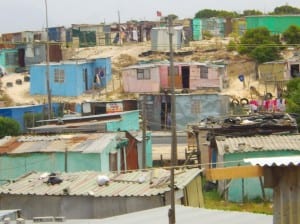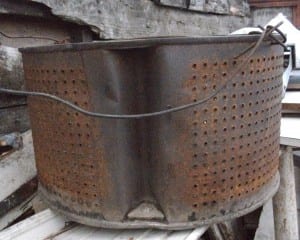Home Heating
Home Heating
Why We Did Not Pursue Heating
During our first few weeks in Monwabisi Park our team conducted interviews and observations of the houses to determine the most dire and specific needs for the residents. We quickly learned that it does get moderately cold in the winter; yet it only lasts about two months and most residents do not have a large concern with home heating. In comparison with cooking which most residents do two to three times a day, heating seemed to be a very minor issue to us. We felt that because the cooking issue was so extensive and most residents had very similar concerns, the effect of our work in this area would have a far greater impact.
Existing Conditions
The existing homes in Monwabisi Park are not well-insulated, which leads to significant energy loss through the walls, windows, and ceilings. This is an important issue because not only is it hard to heat the homes, but also because people end up spending more money than necessary. The poorly-built shacks often have holes and cracks around doors and windows, as well as in the roofs, creating unwanted drafts in the homes and places for energy to escape. The only materials available for insulation are cardboard, newspaper, and metal scraps, none of which are sufficient to reduce energy loss through the building. This decreases energy efficiency in the shacks, forcing people to spend more than necessary to heat the home (WPI CTPC, 2008). An improvement in insulation is a key factor when designing new homes, and is also a consideration when suggesting improvements to the existing homes.
Imbawula
One method of heating is to use an “imbawula,” which is essentially a recycled metal container that is filled with scrap materials that will are burned to produce heat. In 2008, students from WPI surveyed people living in the C-Section of Monwabisi Park about their current heating methods, and discovered that well over sixteen percent admitted to using imbawulas (Kehrer et al, 2008). There is a stigma surrounding the use of imbawulas that those who use it are very poor because they cannot afford fuel. Therefore, it is hard to get accurate numbers of people who use this method, as people are usually too ashamed to admit that they use imbawulas.
Possible Solutions
Insulation
Last year’s project helped implement sandbags as insulation for the walls to help drastically reduce heat loss in the winter. Sand bags were implemented as the primary wall insulation for the new houses. A heat loss analysis should be performed on the new buildings in order to determine if the sand bags provide adequate insulation for the new housing or if more needs to be added.
Aerolite
Numerous companies market insulation with relatively low start up costs. One company, Aerolite, effectively markets its “Think Pink “insulation throughout the region as an affordable eco-friendly option. Aerolite has a wide variety of insulation including glass wool, foam, thermal and fire resistant materials. This insulation can be purchased directly from Aerolite or through a private seller. Aerolite does not list specific prices on their website but a 1 x 10m x 1.2m equal to 12m2 can be purchased for R120 through want ads in the area (Cape Ads, 2009). The relatively low start up cost coupled with the long term savings ceiling insulation can make this a viable option.
For more information on Aerolite, visit their website: http://www.isover.co.za/Product-Range/Aerolite.aspx
Infrared Heaters
Another way to heat homes is by using an infrared heater, which can be powered using electricity or propane, making it less expensive than paraffin. Infrared heaters do not release harmful fumes or greenhouse gases into the air. Another advantage is that electric infrared heaters also don’t rely on fuel or gas lines, which is beneficial to the environment (Jackson, 2009). Infrared heaters also do not emit UV rays. Furthermore, burn hazards are eliminated since most infrared heaters have a protective sheath that covers the heating elements (Global Spec). Therefore, infrared heaters would be healthier for the residents of Monwabisi Park to use to heat their homes, and would also be better for the environment. Since they have a long life expectancy, are easy to install and use, and require little maintenance, the heaters are likely to be sustainable in Monwabisi Park (Alabama Power).
Infrared heaters work by emitting light not visible to the human eye that radiates heat, similar to how sunlight heats. Human skin and clothing absorbs the heat and when the light emitted from the infrared heater is not directed at an object the effect is similar to being in a shaded area away from sunlight. Therefore, infrared heaters are very useful when wishing to heat a particular area or object. While this makes heating an open area in a home more difficult some infrared heaters now contain three parts that create heat. There are infrared light bulbs, a heat exchanger (such as a good metal conductor like copper) and a fan that blows air onto the exchanger to create the heat (Wasch). This air could be used to spread the heat beyond the light’s reach, allowing the infrared heater to function similar to a conventional electric space heater.
There are important parameters that must be considered when specifying an infrared heater, such as: maximum sheath temperature, maximum AC voltage, watts, and maximum watt density. The maximum sheath temperature refers to the highest temperature that material used to cover the heater can reach, and is not related to what is being heated. The maximum AC voltage is the maximum voltage that the heater can use. The wattage available from the heater is represented by watts, where the maximum watt density refers to the amount of wattage for every square inch that the heater is capable of producing. Watt density is a good way to represent how quickly a heater can heat a substance, and is calculated by dividing the available wattage by the total heated area (Global Spec).
A Far Infrared Heater, combines the benefits of a direct infrared heater with an infrared space heater. It is healthful, safe for the residents and environment, cost-efficient, and sustainable. Far Infrared Ray (FIR) energy has a small wavelength – approximately 8-14 microns – which is the optimum energy that is readily absorbed by the human body, making it a great natural healer and maintainer of body vitality. FIR energy also has unique physical properties that can kill bacteria, mildew, and fungi. It also is an excellent drying agent and can eliminate odors. The guard grill, which is used to cover the heater, will only heat to a safe temperature, so a user will not get burned if it is accidentally touched and will not present a fire hazard. It is even designed with a safety button that will cut off the electricity supply to the unit if it is toppled, making it drastically more safe than when using paraffin. It has no emissions, so it is not detrimental to a user’s respiratory system or to the environment. It uses halogen tubes, which have a lower wattage, so it will maintain the same thermal heating while using much less energy than a regular space heater. It also has low and high temperature adjustments and oscillates a full 180 degrees to better heat a space. This design is also easy to use, and uses bulbs that last over 5,000 hours – making it a sustainable home heating option (Tools for Wellness).
For more information on the Far Infrared Heater, click HERE.




